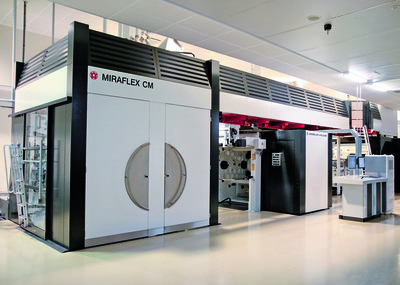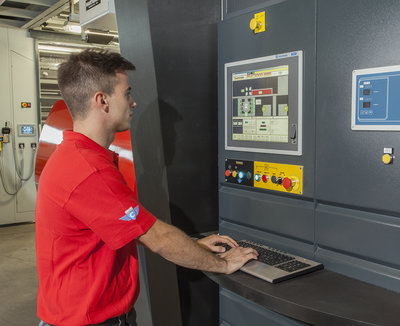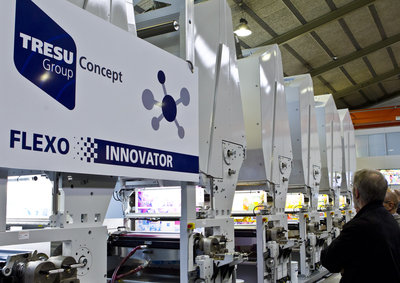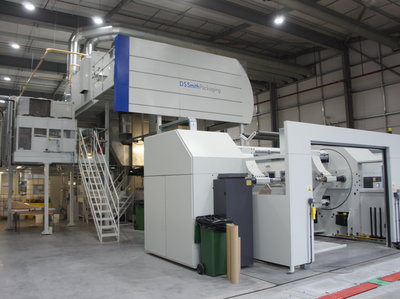DS Smith Belper has installed a bespoke Uteco Diamond press for pre-print liner
Traditional wide web presses today incorporate a large amount of sophisticated automation systems allowing full control of the printing pressure, registration, ink supply, colour management and fault detection. By Neel Madsen.
Presses for wide web printing come in three different configurations, central impression (CI), stack and inline. The CI presses dominate the flexible packaging market at the wider end of the spectrum, running at speeds up to 800 metres per minute (m/min).
Bespoke solution
DS Smith Belper has recently installed a bespoke flexo printing press from Uteco, designed and built to its exact specifications to offer the speed, flexibility and size that is needed for its production of pre-print liner for corrugated packaging. The company supplies premium retail ready packaging to many of Europe’s leading brand owners.
Employing 170 staff, the Belper plant expanded its facilities last year and the £6.1 million investment includes a new print hall to house the 8+1 colour CI HD flexo press, which was developed by the Italian manufacturer at its plant in Verona, in Italy.
‘The press was ready by October 2012 after which the project team, including key suppliers, ran absolute best practice machine commissioning processes for a week on site in Italy whilst the machine was trialled and fingerprinted to specification. It was then shipped to Belper for the final build, which was completed in February 2013, after which the same best practice trials were all repeated,’ explained David Richardson, managing director, DS Smith Speciality Packaging.
The Uteco Diamond 815 press has a web width of 1,850 mm and runs at speeds up to 600 m/min. It has been specified to print onto high performance lightweight liners as low as 60 grammes to help customers achieve their sustainability and environmental targets.
A host of technical features deliver competitive advantage in the production of small, medium and large run orders, including Kiss&Go and Touch&Go for automatic impression setting which reduces set up waste from 250 metres to just 40 metres per colour. Other features are thermoregulation by air of the CI group frame, carbon fibre sleeve mandrels, sleeve ejection system, new and efficient drying system, high performance winders, P2P dynamic adjustment of printing pressures, SprintWash automatic washing system and an upgraded press supervisor, the ShopWareHP.
Mr Richardson said, ‘Flexibility in order to meet our customers’ constantly changing demands was a key demand. This technology offers seamless job changes with minimal set up times and immediate acceleration to maximum speed, giving unprecedented run length flexibility.’
Making it easier
Windmöller & Hölscher introduced the Miraflex CM CI flexo press at drupa 2008. Featuring a host of technical innovations and advantages, it is the successor to the Primaflex, of which the company sold a total of 180.
The CM was followed by the AM model a year later. Between drupa 2008 and drupa 2012, more than 200 Miraflex presses have been sold to companies in 48 countries worldwide. Last year customers in the USA, Canada, Mexico, Brazil, Peru, Argentina, Bolivia, Guatemala, Egypt, Israel, Pakistan, Thailand, Malaysia, Indonesia, Korea, China and Japan bought the AM model, and a majority of these were first time buyers of W&H press technology.
Both the CM and AM press models are available with 8 or 10 colour decks, printing widths from 820 to 1,450 mm, and print repeat lengths up to a maximum of 800 mm, covering the entire range of flexible packaging applications. At drupa 2012, the Miraflex AL and CL models, for extended print repeat ranges, were added to the family of presses. These are specially designed applications such as heavy duty industrial sacks or the printing of outer packaging material.

The Miraflex CM from Windmöller & Hölscher can be fully equipped with the whole range of Easy modules for automation of processes
All press models can be fitted with the company’s Easy modules designed to enhance productivity and sustainability. Easy-Set HD features high resolution topographic print design graphics for exact and fast impression adjustment of anilox rollers and plate cylinders, while Easy-Reg is used for setting the side-lay and flow direction register without register marks.
The Easy-View option is based on an imaging system that processes the data sent from the Easy line camera. This enables viewing and evaluation of the printed image across the entire web width.
Easy-Col is the automation module that permits re-adjustment of the printing inks to the exact given reference value in one or two correction steps. In this way, the exact quantity of inks required for a specific run can be determined and leftover inks reduced to a minimum. The company reports that since its launch five years back, around 100 Easy-Col systems have been installed and are being used on W&H printing presses on five continents.
The newest addition to the Easy family is Easy-Check C, which was launched last year. The system detects ink variations during production and delivers the data for automatic correction of the colour density as well as dot gain. Working in conjunction with Easy-Col, it is possible to maintain any specified ink quality values with maximum consistency, with any deviation and correction values being recorded.
Tailor-made
Italian manufacturer Flexotecnica is also continuing to gain market share around the world through its approach to market leading technology for reduced waste, energy efficiency and award winning print quality.
Over the last 12 months, the Tavazzano-based company has launched the Evo range of presses. The EvoXG and EvoXD are available in widths from 800 to 2,000 mm with print repeats up to 1200 mm, CI drums with 8, 10 or 12 colours and production speeds over 600 m/min for substrates ranging from lightweight PE to 500 gsm folding carton stock.
Each press is built as a tailor-made solution to ensure it meets the product specifications of the individual customer.

Flexotecnica’s new EvoXG and EvoXD presses can be tailored to customers’ individual needs
The company’s proprietary technology for Automatic Impression Setting (AIF) and Automatic Register Setting (ARF) promises significant reductions in set-up waste and downtime.
Both systems are fully integrated within the press controls and print unit positioning architecture to ensure highly accurate operation with all combinations of printing sleeves, intermediates and ITRs giving maximum efficiency gains. The AIF/ARF follow the rapid sleeve changes to minimise changeovers times and press downtime to maximise profitability.
The company is also focused on sustainability, employing efficient motors and drying systems that increase turbulence whilst reducing exhaust volumes and emissions. Further efficiencies have been introduced by the integrations of peripheral technology controls within the press HMI touchscreen such as the ink viscosity system and electrostatic assist controls.
Tim Hilton, sales manager at Cerutti Graphic Systems, added, ‘Flexotecnica offers unique technology within its doctor blade chamber, automated washdown and winding systems that set it aside from the rest of the market place, and combined with strong customer support ethics, this leads to many repeat orders from both multinational and local independents alike.’
New launch
Soma Engineering said it sells 12 to 14 printing presses each year and that its Premia 1,270 mm wide model is the most popular. This model was launched at drupa 2012, along with the Ink Fix colour matching technology, and features the Falcon II automatic impression setting and semi-automatic register system.
For the K Show in Germany in October, the company is preparing to launch a new press, the Optima, described as a compact machine with a small footprint. This was first announced at the RosUpack exhibition in Moscow in June, and this press is aimed at the short run packaging print market.
An agreement between Soma and QuadTech means that the company’s presses can be fitted with inline inspection systems featuring QuadTech’s SpectralCam, PDF verification software and waste management system, which communicates with the Soma slitter rewinder to accurately remove defects from the printed web.
Soma marketing manager, Petr Blaško, commented, ‘We identified that brand owners need spot colours to be printed within required specifications. Together with QuadTech, we introduced the Color Management system at drupa 2012 and are continuously working on improvements. As the quality requirements of print rise each year, it becomes necessary to invest in web inspection or colour measurement equipment as well as web viewing.’
Inline alternative
Danish manufacturer Tresu Group offers an inline alternative in the form of the Flexo Innovator, a press that can comprise an unlimited number of print stations with dryers between 1.8 to 3 metres in length on each unit. This configuration ensures printing quality without the productivity constraints that can arise when printing wet-on-wet with water-based inks and, as seen with some CI presses, reduced drying capacity between the printing stations.
The press comes in three web widths for specific applications between 900 and 1300 mm, enabling printing, varnishing and coating (front and reverse), B3 format sheeting and stacking, creasing and cutting, among other print enhancements.

The Flexo Innovator from Tresu Group is an inline press
Kim Regin-Sustmann, sales director, explained that for food packaging applications, most notably ready meals, paper and carton converters are considering investment in presses with reverse-printing capability so they can apply a coating barrier. This is an attractive alternative to buying relatively expensive board material already laminated with PE material.
Converters are showing interest in acquiring the inside coating capability because it enables them to reduce costs, add value by controlling more operations in house, and standardise material stocks. Creating the coating barrier requires a heavy coating layer, several times thicker than that of ink, and this, in turn, necessitates sophisticated drying.
Inline presses have the flexibility to apply coatings, including those with heavy laydowns, without disruption to the printing sequence in one go, and can accommodate the large drying units needed to circulate the air to remove the evaporation. The longer distance on the line between coating and drying unit allows the medium to achieve the necessary smoothness and settle.
New presses are ergonomically designed, so that the operator has easy access to any point where intervention is required from floor level without risk of strain. Inline configurations therefore facilitate safe and fast changeovers and maintenance, and enable dozens of different jobs to be carried out in a single day.
Mr Regin-Sustmann concluded, ‘Market preferences for more sophisticated product decoration and improved ink bonding performance on plastic are making aqueous inks increasingly viable for flexible as well as carton packaging. And because of this, the integrated flexo line, with its versatility, productivity and superior drying capability, is set to offer a competitive alternative for wide web markets. With a long experience of flexo line technology, we are looking forward to providing converters with bespoke platform to find the edge in this dynamic area of the market.’






